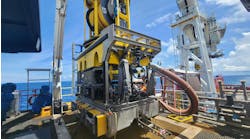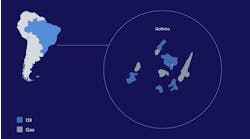D. DeGeer - C-FER Technologies
With ultra deepwater pipelines being considered for water depths of nearly 3,000 m, pipe collapse, in many instances, will govern design. For example, bending loads imposed on the pipeline near the seabed (sagbend region) during installation will reduce the external pressure resistance of the pipeline, and this design case will influence (and generally govern) the final selection of an appropriate pipeline wall thickness.
To date, the deepest operating pipelines have been laid using the J-lay method, where the pipeline departs the lay vessel in a near-vertical orientation, and the only bending condition resulting from installation is near the touchdown point in the sagbend. More recently, however, the S-lay method is being considered for installation of pipelines to water depths of nearly 2,800 m. During deepwater S-lay, the pipeline originates in a horizontal orientation, bends around a stinger located at the stern or bow of the vessel, and then departs the lay vessel in a near-vertical orientation. During S-lay, the installed pipe experiences bending around the stinger (overbend region), followed by combined bending and external pressure in the sagbend region.
Initial bending in the overbend during pipe installation may result in stress concentrations in pipe-to-pipe weld offsets or in pipe-to-buckle arrestor interfaces.
In light of these bending and external pressure-loading conditions, analytical work was performed to better understand the local buckling behavior of thick-walled line pipe due to bending, and the influence of bending on pipe collapse. Variables considered in the analytical evaluations include pipe material properties, geometric properties, pipe thermal treatment, the definition of critical strain, and imperfections such as ovality and girth weld offset.
Design considerations
As the offshore industry engages in deeper water pipeline installations, design limits associated with local buckling must be considered and adequately addressed. Instances of local buckling include excessive bending resulting in axial compressive local buckling, excessive external pressure resulting in hoop compressive local buckling, or combinations of axial and hoop loading creating either local buckling states. In particular, deepwater pipe installation presents perhaps the greatest risk of local buckling, and a thorough understanding of these limiting states and loading combinations must be gained in order to properly address installation design issues.
Initial bending in the overbend may result in stress concentrations in pipe-to-pipe weld offsets or in pipe-to-buckle arrestor interfaces. Initial overbend strains, if large enough, may also give rise to increases in pipe ovalization, perhaps reducing its collapse strength when installed at depth. Active bending strains in the sagbend will also reduce pipe collapse strength, as has been previously demonstrated experimentally.
Overall modeling approach
In an attempt to better understand pipe behavior and capacities under the various installation loading conditions, the development and validation of an all-inclusive finite element model was performed to address the local buckling limit states of concern during deepwater pipe installation. The model can accurately predict pipe local buckling due to bending, due to external pressure, and to predict the influence of initial permanent bending deformations on pipe collapse. Although model validation is currently being performed for the case of active bending and external pressure (sagbend), no data has been provided for this case.
The finite element model developed includes non-linear material and geometry effects that are required to accurately predict buckling limit states. Analysis input files were generated using our proprietary parametric generator for pipe type models that allows for variation of pipe geometry (including imperfections), material properties, mesh densities, boundary conditions and applied loads.
A shell type element was selected for the model due to increased numerical efficiency with sufficient accuracy to predict global responses. The Abaqus S4R element is a four-node, stress/displacement shell element with large-displacement and reduced integration capabilities.
All material properties were modeled using a conventional plasticity model (von Mises) with isotropic hardening. Material stress-strain data was characterized by fitting experimental, uniaxial test results to the Ramberg-Osgood equation.
Pipe ovalizations were also introduced into all models to simulate actual diameter imperfections, and to provide a trigger for buckling failure mode. This was done during model generation by pre-defining ovalities at various locations in the pipe model.
Bending case
A pipe bend portion of the model was developed to investigate local buckling under pure moment loading. Due to the symmetry in the geometry and loading conditions, only one half of the pipe was modeled, in order to reduce the required computational effort. The pipe mesh was categorized into four regions
- Two refined mesh areas located over a length of one pipe diameter on each side of the mid-point of the pipe to improve the solution convergence (location of elevated bending strains and subsequent buckle formation)
- Two coarse mesh areas at each end to reduce computational effort.
Clamped-end boundaries were imposed on each end of the pipe model to simulate actual test conditions (fully welded, thick end plate). Under these assumptions, the end planes (nodes on the face) of both ends of the pipe were constrained to remain plane during bending. Loading was applied by controlled rotation of the pipe ends.
In terms of material properties, the axial compressive stress-strain response tends to be different from the axial tensile behavior for UOE pipeline steels. To accurately capture this difference under bending conditions, the upper (compressive) and lower (tension) halves of the pipe were modeled with separate axial material properties (derived from independent axial tension and compression coupon tests).
In general, the local compressive strains along the outer length of a pipe undergoing bending will not be uniform due to formation of a buckle profile. In order to specify the critical value at maximum moment for an average strain, four methods were selected based on available model data and equivalence to existing experimental methods.
Collapse case
The same model developed for the bending case was used to predict critical buckling under external hydrostatic pressure. This included the use of shell type elements and the same mesh configuration. In the analyses, a uniform external pressure load was incrementally applied to all exterior shell element faces. Radially constrained boundary conditions were also imposed on the nodes at each end of the pipe to simulate actual test conditions (plug at each end). In contrast to the pipe bend analysis, only a single stress-strain curve (based on compressive hoop coupon data) was used to model the material behavior of the entire pipe.
Bending case validation
The pipe bend finite element model was validated using full-scale and materials data obtained from the Blue Stream test program, both for “as received” (AR) and “heat treated” (HT) pipe samples. Geometrical parameters were taken from the Blue Stream test specimens and used in the model validation runs. Initial ovalities based on average and maximum measurements were also assigned to the model. The data distribution reflects the relative variation in ovality measured along the length of the Blue Stream test specimens.
All of finite element models included analysis input files generated using parametric generator for pipe type models that allows for variation of pipe geometry (including imperfections), material properties, mesh densities, boundary conditions, and applied loads.
Axial tension and compression engineering stress-strain data used in the model validation were based on curves fit to experimental coupon test results. As pointed out previously, separate compression and tension curves were assigned to the upper and lower pipe sections, respectively, in order to improve model accuracy.
In the validation process, a number of analyses were performed to simulate the Blue Stream test results (base case analyses), and to investigate the effects of average strain definition, gauge length, and pipe geometry. These analyses, comparisons and results were:
- The progressive deformation during pipe bending for the AR pipe bend showed the development of plastic strain localization at the center of the specimen
- A comparison between the resulting local and average axial strain distributions for two nominal strain levels indicated that at the lower strain level the distribution of local strain is relatively uniform, at the critical value (peak moment) a strain gradient is observed over the length of the specimen with localization occurring in the middle, the end effects are quite small due to specimen constraint and were observed at both strain levels
- The resulting moment-strain response for the AR pipe base case analysis found the calculated critical (axial) strain slightly higher than that determined from the Blue Stream experiments
- The effect of chosen strain definition and gauge length on the critical bending strain for the AR pipe base case analysis, using the four methods for calculating average strain, gave similar results
- The critical strain value is somewhat sensitive to gauge length for a variety of OD/t ratios
- The finite element results are seen to compare favorably with existing analytical solutions and available experimental data taken from the literature. For pipe under bending, heat treatment results in only a slight increase in critical bending strain capacity.
Collapse case validation
Similar to the pipe bending analysis, the plain pipe collapse model was also validated using full-scale and materials data obtained from the Blue Stream test program, both for “as received” (AR) and “heat treated” (HT) pipe samples. Pipe geometry and ovalities measurements taken from the Blue Stream collapse specimens were used in the validation analyses. Initial ovalities based on average and maximum measurements were also assigned to the model at different reference points. Hoop compression stress-strain data was used in the model, and was based on the average of best fit curves from both ID and OD coupon specimens, respectively. To validate the pipe collapse model, comparison was made to full-scale results from the Blue Stream test program which demonstrated a very good correlation between the model predictions and the experimental results.
In addition to the base case, further analyses were run for a number of alternate OD/t ratios ranging from 15 to 35. Similar to the pipe bend validation, the OD/t ratio was adjusted by altering the assumed wall thickness of the pipe. The finite element results have compared favorably with available experimental data taken from the literature.
The beneficial effect of pipe heat treatment for collapse has resulted in a significant increase in critical pressure (at least 10% for an OD/t ratio of 15). The greatest benefit, however, is observed only at lower OD/t ratios (thick-wall pipe). This can be attributed to the dominance of plastic behaviour in the buckling response as the wall thickness increases (for a fixed diameter). At higher OD/t ratios, buckling is elastic and unaffected by changes in material yield strength.
Pre-bent effect on collapse
Finite element analyses were also performed to simulate recent collapse tests conducted on pre-bent and straight UOE pipe samples for both “as received” (AR) and “heat treated” (HT) conditions. The intent of these tests was to demonstrate that there was no detrimental effect on collapse capacity due to imposed bending as a result of the overbend process. In the pre-bend pipe tests, specimens were bent up to a nominal strain value of 1%, unloaded, then collapse tested under external pressure only.
To address the pre-bend effect on collapse, a simplified modeling approach was used whereby the increased ovalities and modified stress-strain properties in hoop compression due to the pre-bend were input directly into the existing plain pipe collapse model (the physical curvature in the pipe was ignored).
To address this loading case, a simplified modeling approach was used whereby the increased ovalities and modified stress-strain properties in hoop compression due to the pre-bend were input directly into the existing plain pipe collapse model (the physical curvature in the pipe was ignored).
A comparison between the predicted and experimental collapse pressures for both pre-bent and straight AR and HT pipes indicates that the model does a reasonable job of predicting the collapse pressure for both pipe conditions. It is also clear that the effect of moderate pre-bend (1%) on critical collapse pressure is relatively small.
While the pre-bend cycle results in an increased ovality in the pipe, this detrimental effect is offset by a corresponding strengthening due to strain hardening. As a result, the net effect on collapse is relatively small. For the AR pipe samples, there was a slight increase in collapse pressure when the pipe was pre-bent. Conversely, for the HT pipe, the opposite trend was observed. This latter decrease in collapse pressure can be attributed to two effects: the larger ovality that resulted from the pre-bend cycle and the limited strengthening capacity available in the HT pipe (the HT pipe thermal treatment increased the hoop compressive strength, offering less availability for cold working increases due to the pre-bend).
Similar to previous experimental studies on thermally aged UOE pipe, the beneficial effect of heat treatment was demonstrated in the pre-bend analysis. The collapse pressure for the pre-bent heat treated (HT) pipe is approximately 8-9% higher than that for the as received (AR) pipe, based on both the analytical and experimental results. This increase, however, is lower than that observed for un-bent pipe (approximately 15-20% based on analysis and experiments).
This unique case of an initial permanent bend demonstrated that the influence on the collapse strength of a pipeline was minimal resulting from an increase in hoop compressive strength (increasing collapse strength), and an increase in ovality (reducing collapse strength). This directly suggests that excessive bending in the overbend will not significantly influence collapse strength.
Future work includes advancing the model validation to the case of active bending while under external pressure. This condition exists at the sagbend region of a pipeline during pipelay and, in many cases, will govern overall pipeline wall thickness design.
Acknowledgments
The authors would like to acknowledge the support of this program by Medgaz SA and the technical contributions of Medgaz personnel throughout the model development phase.
Editor’s Note: This a summary of the OMAE2006-92173 paper presented at the 2006 OMAE conference in Hamburg, Germany, June 4-9, 2006






